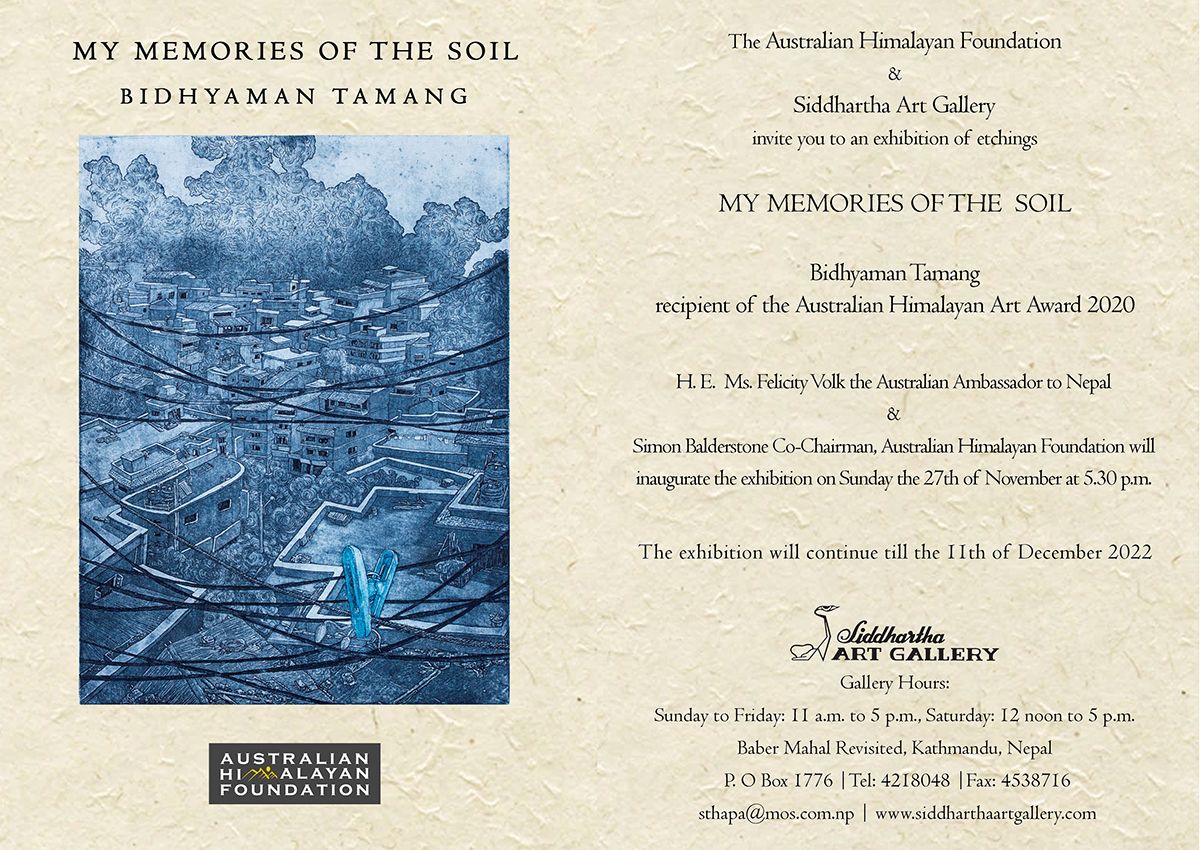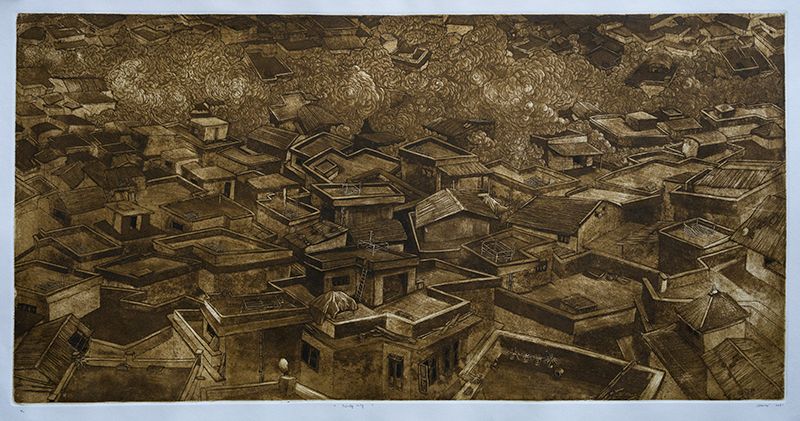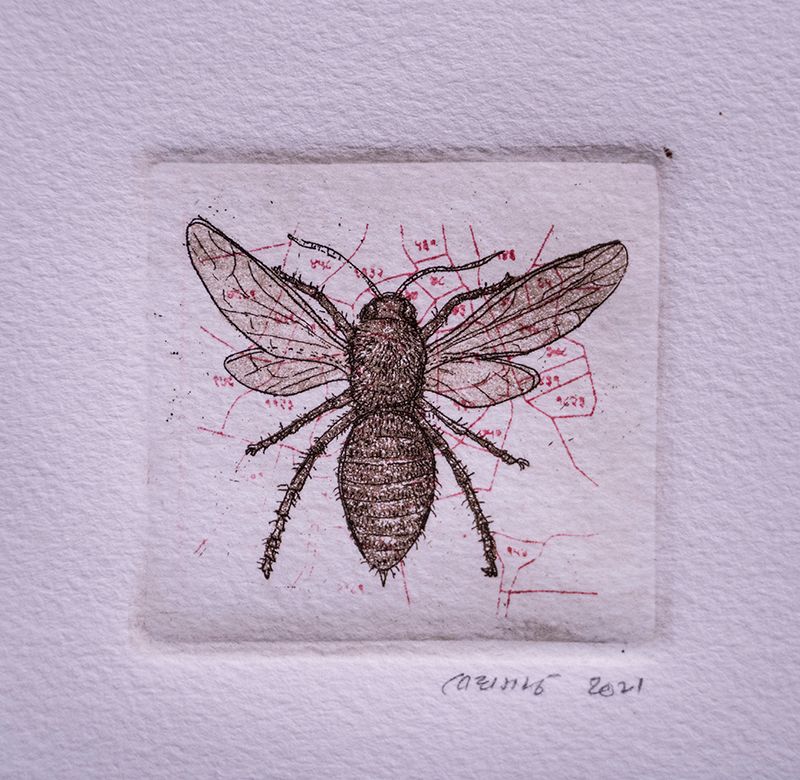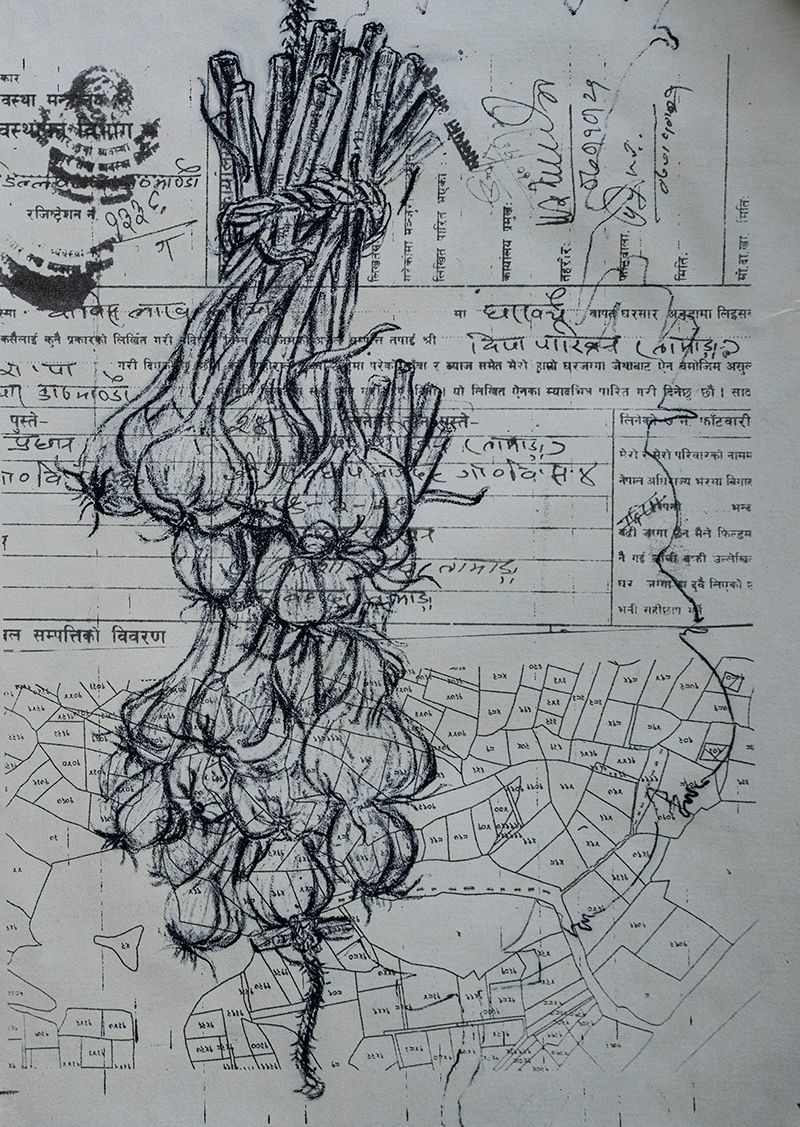
किसान
सानो छ खेत, सानो छ बारी, सानै छ जहान
नगरी काम, पुग्दैन खान, साँझ र बिहान ।।
बिहानपख झुल्किन्छ घाम देउराली पाखामा
असारे गीत घन्किन्छ अनि सुरिलो भाकामा ।।
काँधको शोभा हलो र जुवा हातमा कोदाली
जीवन धान्न गर्नु नै पर्ने उकाली ओराली ।।
छुपु र छुपु हिलोमा धान रोपेर छोडौँला
बनाई कुलो लगाई पानी आएर गोडौँला ।।
भनेर सानी पटुकी रातो बाँधेर झरेकी
धमिलो खोला बाढीले होला कसरी तरेकी !
गालामा साना पसिना दाना मोतीझैँ खुलेकी
घाम र पानी भोक र तिर्खा कसरी भुलेकी ।
सुसेली हाली बयेली खेल्छ बतास रातमा
जूनले पोख्छ शीतका थोपा धानका पातमा ।।
सुनौला बाला झुलेर होला भुइँलाई छोएको
फलेको हाँगो कहिले छ र ननुही रहेको ?
हिमाल हाँस्छ मिलाई सेता दाँतका लहर
किसान बनी जहान पाल्ने यो मेरो रहर ।।

WHEN: 27th November to December 11th, 2022
WHERE: Siddhartha Art Gallery
Bidhyaman Tamang on receiving the award:

Gallery Statement
I first noticed Bidhyaman Tamang’s works when he exhibited his etchings at the Amalgam show hosted by the Siddhartha Art Gallery. A scarecrow resurrected from an abandoned farmland hovered like a ghost above the cityscape filled with haphazard urban structures. Another etching provided a powerful narrative on how farmlands were being commercially plotted to house the ever-burgeoning population of Kathmandu. As the son of farmers, Tamang’s works are deeply personal – the artist uses his own visage over which he superimposes the plots of his family’s farmland that have changed hands. His etchings chronicle the harsh reality of occupational and urban transformation. One etching documents farming tools neatly hung on the wall with a fog and a mouse perched on either side. Who will inherit these tools and this legacy, once the land is gone?
Bidhyaman’s works strike an emotional chord with the viewers, as we too have been witness to the rapid urban transformation that is taking place before our very eyes. Farming was the most important occupation of the Nation half a century ago and from a country that exported rice, we have now transitioned into a nation that is now importing rice. The recurring theme of land and memory, land and nature, and nature and man are rooted in Bidhyaman’s mind and heart. His etchings are imbued with nostalgia about a time past. His works provoke a profound sense of loss – looking at his etching of the insects associated with his farmland, I too felt nostalgic about the fireflies that once swarmed the skies and my garden in the month of June. The fireflies have disappeared like the house sparrow and the swallow. Ironically, we now need to remind ourselves about the existence of the sparrow on the 20th of March which is World Sparrow Day.
Bidhyaman’s etchings are a sensitive narration of the ecological price that we have to pay as farmlands are sold, forests are razed and the land is turned into barren sods of soil that cannot even sustain the insects that once thrived there. Right across the country, as roads are being built, trees are being felled and vast swathes of forests are being felled in the name of development, species of birds, animals, reptiles, and insects are being displaced. There is talk about human displacement but we fail to see the larger picture and the interconnectedness that we share with nature – the loss of natural habitat means that animal and human confrontations will increase, pollination will be problematic, agricultural yields will dwindle and we will soon find ourselves in an ecological nightmare. Can Bidhyaman’s memories of the soil provoke us into action? I do believe that his works arouse in us a desire to explore our own connection to the land of our birthplace, to the land that we live on, and to a utopian dreamland where man and nature can exist in harmony. Above all his works are imbued with an urgent message, that if we nurture the soil, we can save humanity itself.
Sangeeta Thapa
Founder Director
Siddhartha Art Gallery | Siddhartha Arts Foundation
Founder Chair
Kathmandu Triennale

About The Artist
BIDHYAMAN TAMANG, was born in Ramechhap. He is among one of many generations of Nepalis that have been up-rooted from their villages. Bidyaman migrated to Kathmandu at an early age. Over the latter half of the 20th century, many individuals from across Nepal migrated to cities in search of better opportunities. More recent movements to the Middle East and Southeast Asia have further left many villages bereft of youth.
‘My Memories of the Soil” is an ode to his childhood in Ramechhap. Born to a family of farmers, he remembers the sounds, colors and the anatomy of the insects. Often times he would play with the insects on the farmland. His artworks offers glimpses into a familiar yet distant world-of arthropods and pastures, of crops and eco systems, of soil and memories that find little space in an urbanized world. Insects, wildlife, crops and farmlands have been the locus and inspiration for his art practice.
The artist challenges the audience to consider the impact of a booming ever-speculative Nepali real estate market that is transforming farmlands into concrete dystopias. As farms are transmogrified into coveted holdings, the extinction of insects continues and our former relationship to land crumbles. Bidyaman’s community no longer has the vast green fields with a thriving ecosystem of its own, instead there are commercially plotted land which will eventually be burdened with concrete structures. His artworks are an attempt to give arthropods and insects space in an urbanized world, which may have no place for them if such developments continue to grow unchecked. The fast urbanization of ancestral lands evokes a sense of loss while still eliciting a feeling of belonging. The artist’s attachment to the place where he was born remains despite the loss of many crucial connections to the community over the years. This series of work began as a way of finding his own roots. His works are visual representation of his childhood memories that are imbued with nostalgia and a fascination with what the lands of Ramechhap offered him decades ago.
“My Memories of the Soil” is a powerful narrative of Bidyaman’s deep connection to nature.

Inaugural Speech by H.E. Felicity Volk, Australian Ambassador To Nepal
I’m absolutely delighted to be joining this event. My thanks to Sangeeta and Siddhartha Art Gallery for hosting us and to the Australian Himalayan Foundation represented here tonight by Dick Estens, for its support of this event and the AHF Himalayan Art Award.
I’m proud of the many contributions AHF and its supporters have made to Nepal during the foundation’s 20 years of partnering the communities of the Himalayas. And tonight, I’m especially pleased to celebrate this art award, which reminds us that countries like Nepal and Australia, which seems so far apart in geography, in miles, perhaps even in culture, are in fact so close in terms of a shared love of the arts and a shared appreciation of artists.
There are things that divide us as communities, nations and as a planet – and we have seen many of them in the past two years: the pandemic; Russian’s invasion of Ukraine; approaches to climate change, water sharing and food insecurity; approaches to gender equality in places like Iran; the treatment of Indigenous and ethnic groups, migrant workers and LGBTQI people; abuses of human rights.Our media headlines are replete with these. And I suspect my response is shared by many of us here – a world weariness at times, a yearning for a respite from it all, a wish to rest in a more hopeful, optimistic, and healing place.
There are many things that divide us, but there are also things that brings us together – the arts.There are many things that erode us, but there are also things that nuture, that call us to walk carefully and mindfully through our world – the arts.And that is what we are here to celebrate tonight in Bidhyaman Tamang’s work.
This exhibition, My Memories of the Soil, is described as an ode to Bidhyaman’s childhood in Ramechhap. Bidhyaman takes us back with him to his roots and to ours. To the soil from which we have all come, the insects that burrow through it and hover above it, the seeds that unfurl from it into the plants, the food, the crops that nourish us.
But in taking us back with nostalgia, Bidhyaman reminds us what we have lost and how we have even more to lose if we are not mindful of what is at stake. If we don’t make considered choices. If we fail to treat our environment with respect, care and tenderness.His work holds us in that painful place of contradiction which is the hallmark of the finest art. In each print, Bidhyaman invites us into a moment that at once celebrates our sense of belonging to the land, the soil, but is simultaneously haunted by the pain of disconnection. We have been transplanted from soil to concrete, from field to urban landscape. And around us, Bidhyaman’sinsects buzz both an ancient lullaby and a contemporary lament.
Today, the world looks more troubled than it has at any point in my lifetime.And today, more than ever, we celebrate and support our artists, through awards like the AHF Himalayan Art Award, because we need them. In time of crisis, we need the humanity, the self-expression, the wisdoms, the healing and the community that artists create and nourish.
In our tumultuous world, art matters. We rely on our artists to help us understand and express our world in both its pain and its beauty. We rely on them to encourage justice and healing, to help us remain rooted in our culture, connected to the soil in the case of Bidhyaman’s work and connected to each other, and we rely on our artists to articulate a vision for something better, brighter and which offers hope. So, to Bidhyaman Tamang and to all awardees of the Himalayan Art Award since its inception in 2008, including the most recent recipient, Muna Bhadel, I offer our communal gratitude.
Recipients of the Himalayan Art Award have woven as a golden thread through my almost two years here as Australia’s Ambassador. I met Sujan Dangol, 2013 recipient during a group exhibition here at Siddhartha last year. I was first introduced to Bidhyaman at the Kathmandu Triennale. I see the work of 2016 recipient, Kiran Maharjan every day as it adorns the street facing wall of the Australian Embassy. Each day, Nepali art reassures me that as much as I am an outsider, looking in on Nepal’s rich, ancient and also contemporary culture, I am an insider too. Because both the making and the viewing of art connects us to a universal experience, it makes the unfamiliar familiar, and it tells us that we each belong to the one shared story.
The return of the Kathmandu Triennale in February this year, bigger and better, the inaugural Nepal pavilion at the 59th Venice Biennale in April 2022, Nepal’s artists being represented in greater numbers than ever in the permanent collections of major museums and galleries, in great part thanks to the efforts of Sangeeta for which she has rightly been recognised through a Suprabal Jana SewaShree award by the Government. All of these speak to a coming of age, not so much of Nepali art - which has for centuries been mature and confident - but of the art world’s understanding of the incredible talent of Nepal’s artists. And I’m proud that Australians, through the AHF Himalayan Art Award are playing a part in introducing the world to some of Nepal’s extraordinarily gifted emerging artists.
I congratulate AHF supporters for this, I congratulate Sangeeta for providing a platform for this cooperation, but most of all, I congratulate Nepal’s artists – tonight the 2022 award recipient, Muna Bhadel. And of course Bidhyaman, for sharing his intimate childhood memories with such exquisite tenderness and sobering warning, calling us all to treat our environments, in Nepal, in Australia, wherever we call home, with love and respect.
Dhanyabad.
